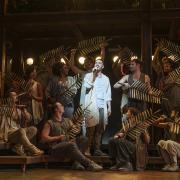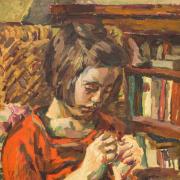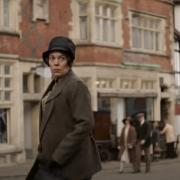Solution for the “Once Upon a Time…” piece by Tony Ward in the Sussex Life June issue
Who is it? ‘Once Upon a Time’…
Scientist, artist, illustrator,
writer, farmer, conservator,
a restless spirit, a driven pen.
.
Fungi, fur and feather,
mice, rabbits, cats,
a hedgehog and some bats,
invading her life,
colouring her world.
.
Letters to children with pencilled pictures,
children of family, children of friends.
Simple pleasures.
.
Annie’s spur, the Canon’s faith,
little books for little hands,
a spreading stream of tales and tails.
.
Winters by the sea, wet weeks.
Letters to Marjory, to Frida, to Noel...
the brown sail boats, the brown dog saved.
Stories in a schoolbook, the very wet week.
.
Summers in the Lakes, walks on the Fells
forever.
New home, new love, new roots.
Raising sheep, raising hopes,
Restoration, preservation, conservation.
Her trust in land, her land in Trust.
.
Anniversaries, connections,
Fifty pence for the writer,
Fifty pence for the battle,
A lost book for the Laureate.
Solution – Beatrix Potter - best known for her Peter Rabbit series of children’s books.
Explanation of embedded clues
Beatrix Potter is naturally associated with her later life in The Lake District, and particularly her purchase of her beloved Hill Top Farm, now in the care of The National Trust. She did not move permanently to The Lake District though until 1905, at the age of 39, after her first five Peter Rabbit Books had been published. It was the proceeds from these books together with a legacy from an aunt which enabled her to buy Hill Top in the village of Near Sawrey. Beatrix knew the village from a long family summer holiday spent there in 1896, and from that point on it appears that her ambition was to settle there, “It’s as nearly perfect a little place as I have ever lived in.” Until the dream could become a reality though, she lived with her parents in London.
The main Sussex connection is with Hastings, although Winchelsea also figures. During the winter months between 1898 and 1907, Hastings was her regular winter holiday base, usually staying at No. 16 Robertson Terrace – “Winters by the sea” (verse 5). She wrote of “wet weeks”. While on holiday, as was her custom, she wrote what she called ‘picture letters’ to children of friends and family – “Simple pleasures”. The recipients of some of the Hastings letters were Marjory, Frida and Noel.
In an 1898 letter to Noel she writes of ships passing outside the Royal Sovereign lightship and about the Hastings fishing boats, ‘very pretty, painted bright colours and have all got brown sails’. She also told of a fisherman who, ‘told me had caught conger eels 20 feet long, which made me laugh, for they are savage!’
Noel had been a regular recipient of Potter’s letters for several years. He was the son of her final governess and Lady’s Companion, Annie Moore. Annie was appointed when Beatrix was aged 16, and was herself only three years older. They kept in touch. When Beatrix was aged 27, and on holiday in Scotland in the summer of 1893, she had written a ‘picture letter’ to Annie’s then six year old son. Noel was often ill and welcomed Beatrix’s letters. This time though Beatrix was a bit stuck for news and so she wrote:
My dear Noel, I don’t know what to write to you, so I shall tell you a story about four little rabbits whose names were – Flopsy, Mopsy, Cottontail – and Peter. They lived with their mother in a sand bank under the root of a big fir tree ...
Annie was the “spur” who prompted Potter to use the ‘picture letter’ as the basis for a book. And so was born The Tale of Peter Rabbit.
Another recipient of a Hastings holiday letter was Frida, who was told of a narrow escape for ‘a very nice brown terrier dog’. There had been an overnight storm in which seafront railings had been knocked over. The dog chased a stone over the sea wall ‘before anyone could stop it’ but luckily ‘the next big wave threw it out again into the road’.
In another Hastings letter, this time to Marjory as well as her sister Frida (sic) dated January 26th 1900, she writes, “I wonder if I have spelt your name right this time! If I have not, you will say I ought to go to school too, and learn out of a big spelling book”. The girls and their brother attended school, but both Beatrix and her younger brother Bertram’, born into a privileged household, had been privately educated by governesses in their own schoolroom in the family home.
Two months later and back in London, Potter confides in Marjory about her attempts to get her book, The Tale of Peter Rabbit, published. Potter wrote to Marjory:
I don’t think (Noel’s letter) will be made into a book this time because the publisher wants poetry ... he wants a bigger book than he has money to pay for! And Miss Potter has arguments with him. I think Miss Potter will go off to another publisher soon! She would rather make 2 or 3 little books costing 1/- (one shilling) each, than one big book costing 6/- because she thinks little rabbits cannot afford to spend 6 shillings on one book, and would never buy it.
Famously, Beatrix Potter eventually got her own way. The book was taken on by Frederick Warne & Co., and as they say, the rest is history! Both publisher and author were to make considerable fortunes out of the “little books for little hands”.
The final Hastings holiday anecdote takes place in the week 26 November to 3 December 1903. It rained nearly every day of her stay, “the very wet week”. But it proved to be very productive. In a stiff-covered exercise book Beatrix planned out no less than three stories, all of which were subsequently published. The first she titled The Tale of Hunca Munca or The Tale of Two Bad Mice. This was published the following year together with The Tale of Benjamin Bunny. Potter liked to have two books on the go at any one time. The second story appears in the exercise book as Something very very NICE. This was to be later re-written but retaining the same central characters, Ribby the cat and Duchess the dog. It was published in 1905 under the title The Pie and the Patty-Pan. The last story The Tale of Tuppenny was incomplete but eventually appeared in 1973 with illustrations by Marie Angel. Hastings certainly contributed to Beatrix Potter’s legacy.
Looking now at some of the other references in the poem. “Scientist” refers to Potter’s pre-Peter Rabbit work in the field of mycology, in particular her study of Fungi, all superbly illustrated. Her research led her to reject the existing theory regarding how fungi reproduced. Her paper was presented to the Linnean Society in 1897 by a leading botanist from Kew Gardens. This was because women could not attend proceedings or read papers. In 1997, the Linnean Society issued a posthumous apology for the sexism displayed in its handling of her research. Some of her scientific drawings can be seen at the Armitt Museum and Library in Ambleside and also in the Perth Museum and Art Gallery. They are still a valuable resource for mycologists.
“Farmer, conservator” (verse 1) and all of verse 6, refer to Beatrix Potter’s later life in the Lake District. In 1905 her “Summers in the Lakes, walks on the Fells” were to become “forever”. That November she was able to buy Hill Top Farm. This was not without a degree of sadness though. In July of that year she had become unofficially engaged to her editor Norman Warne. It was ‘unofficial’ because her parents objected to her marriage to someone “in trade”. The hope may have been that Hill Top would be their holiday home. Tragically though Warne died of leukaemia exactly one month after their engagement. Potter went ahead with the purchase. Perhaps it now had even greater meaning for her.
Being new to the area, as a new farmer and landowner, and as she added to her holdings, she needed legal advice. She engaged a respected local firm of solicitors in nearby Hawkshead, W.H. Heelis & Son. William Heelis acted for her. Working together they became close and it was only a matter of time before they got married, on 15 October 1913. They moved into Castle Cottage, Potter’s second, 1909, acquisition, across the road from her tenanted Hill Top working farm, “New home, new love, new roots”. Potter also remodelled Hill Top slightly so as to incorporate a studio, a place for her to work.
Potter continued to produce Peter Rabbit books but now on a reduced scale. Her main interests now were “Raising sheep, raising hopes/ Restoration, preservation, conservation”.
She was a prize-winning breeder of Herdwick sheep and keenly interested in preserving the Lake District landscape and way of life. “The Canon’s faith” (verse 4) refers to Canon Hardwicke Rawnsley, a family friend, whom she had first met when she was aged 16. It was he who had first made the rounds of London publishers with an early version of the original Tale of Peter Rabbit. At the time that Potter re-located to the Lake District Hardwick Rawnsley was deeply involved in land conservation and preservation. He was to become one of the three founders of The National Trust. He was a great inspiration to Beatrix.
In 1930 the Heelises became partners with the National Trust in buying and managing fell farms over a wide area. For seven years, until The National Trust could raise the money to buy back most of this property from her, Beatrix Potter was effectively their estate manager. After the deaths of Beatrix and then William, eighteen months later, all their properties were left to The National Trust. They had amassed over 4,000 acres, 17 farms and 8 cottages. It was a major contribution to what later became The Lake District National Park, designated in 1951, “Her trust in land, her land in Trust”.
The phrase “raising hopes” refers to another philanthropic cause of Potter’s, one that is less well-known. In 1919, immediately after the First World War, Beatrix established a District Nursing Trust in the Sawrey area to improve local health care.
The final verse, “Anniversaries, connections”, brings us back to Hastings. The year 2016 is both the 150th anniversary of Beatrix Potter’s birth and the 950th anniversary of the Battle of Hastings. Both are commemorated by the issue of general circulation fifty pence coins. The reverse side of Potter’s coin features her name, dates, her profile and an image of Peter Rabbit.
The “lost book for the Laureate” also has a Hastings connection. In 2015 a manuscript for an unpublished Beatrix Potter book was discovered in the Victoria & Albert Museum archive. There was however only one drawing. It was of ‘a rather dapper black cat wearing hunting garb and carrying a game bird’, not a lot to go on! It was decided to ask Quentin Blake to produce a full set of drawings. Quentin Blake is perhaps best known to children as the illustrator of Roald Dahl’s books. He was also the first writer to be appointed as Children’s Laureate. Although he has lived in South Kensington for the last 30 years, ‘I love the seaside and spend quite a lot of time in Hastings on the South Coast”. He is a regular visitor to the Jerwood Gallery.
The Tale of Kitty-in-Boots joins the other 23 Peter Rabbit Books, after a slight delay of some 100 years. But then, as I suspect Beatrix Potter may have pointed out, kittens are not always good timekeepers.
Acknowledgement of sources:
• Beatrix Potter, The Peter Rabbit Books (23 volumes), Frederick Warne.
• Judy Taylor, Letters to Children from Beatrix Potter, Penguin.
• en.wikipedia.org/wiki/Beatrix_Potter
• www.beatrixpottersociety.org.uk
• www.bpotter.com (‘BEATRIX POTTER : A Life in Nature’ by Linda Lear, historian and prize-winning biographer of Beatrix Potter).
• publicdomainreview.org/2014/07/23/the-tale-of-beatrix-potter (An extensively illustrated and insightful review of Beatrix Potter’s life and work by Frank Delaney, author and broadcaster, with useful links to her works).
• collections.vam.ac.uk/item/O1264945/drawing-beatrix-potter (a pencil sketch of a street scene in Hastings or Winchelsea, most probably drawn around 1900 during one of her winter holidays. Now in the V&A Museum Collection).
• Relevant websites found by searches for ‘Beatrix Potter’, ‘Beatrix Potter in Hastings’, Beatrix Potter quotes’, ‘Quentin Blake and Beatrix Potter’s lost tale’.


























